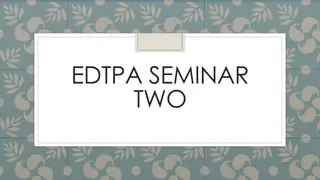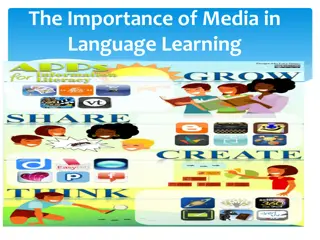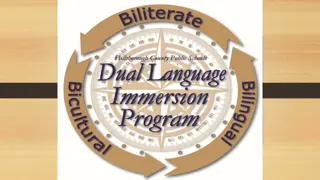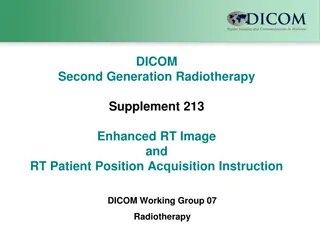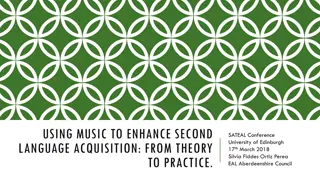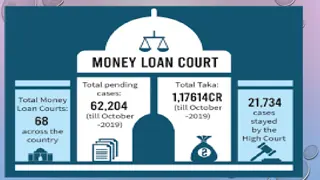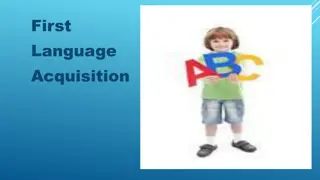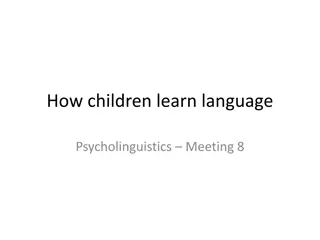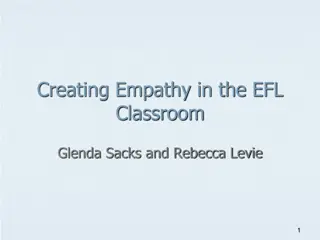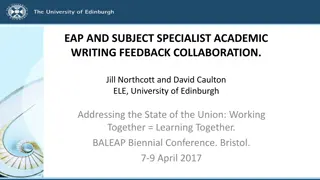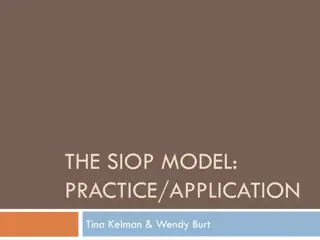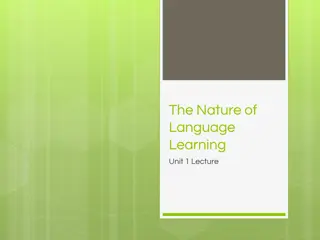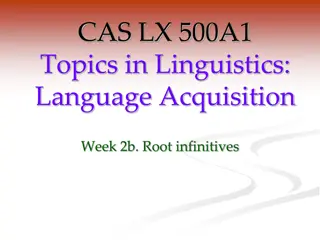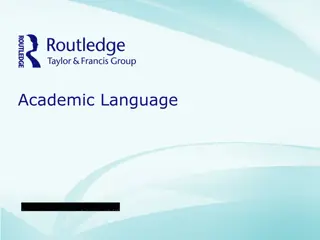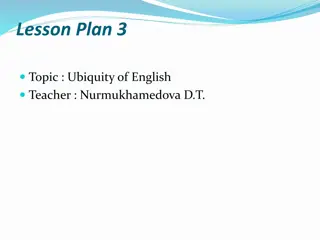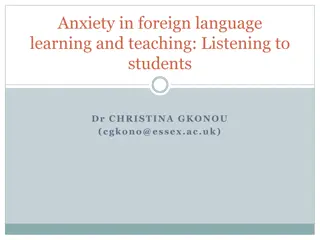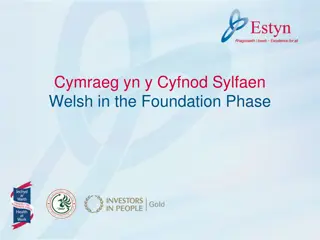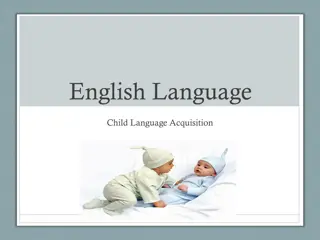
Academic Language Acquisition and Development Workshop
Explore the importance of academic language, its definition, and tools to measure it in a workshop designed to support educators in enhancing instructional programs for all students. Join us to raise awareness and understanding of complex language demands in 21st-century learning environments.
Download Presentation

Please find below an Image/Link to download the presentation.
The content on the website is provided AS IS for your information and personal use only. It may not be sold, licensed, or shared on other websites without obtaining consent from the author. If you encounter any issues during the download, it is possible that the publisher has removed the file from their server.
You are allowed to download the files provided on this website for personal or commercial use, subject to the condition that they are used lawfully. All files are the property of their respective owners.
The content on the website is provided AS IS for your information and personal use only. It may not be sold, licensed, or shared on other websites without obtaining consent from the author.
E N D
Presentation Transcript
Notes to Facilitator Thanks for your support in facilitating these important conversations. Notes: Times suggested on slides are guidelines to assist keeping this topic to an hour. Use them as you wish. March convening will hold a breakout session to further support understanding and application of academic language. 1
Regional Regional I Improvement Network mprovement Network Culture, Equity, and Academic Language Acquisition Culture, Equity, and Academic Language Acquisition Office of Student and School Success February 17 February 17th th , 2016 , 2016
Academic Language Continued Academic Language Continued Objectives and Success Criteria Objectives and Success Criteria Objectives: Define academic language. Identify 2-4 reasons why an academic language focus will strengthen the core instructional program for all students. Determine tools to measure academic language. Success Criteria: Establish an application for the information learned on academic language. Guiding Question: How can we raise awareness with school leadership and teachers about the complex academic language demands of 21st century learning?
What is Academic Language? Academic Language is the set of words and phrases that: (1) describe content-area knowledge and procedures (2) express complex thinking processes and abstract concepts (3) create cohesion and clarity in written and oral discourse. Educational Leadership, December 2004/January 2005 | Volume 62 | Number 4 , Jeff Zwiers 4
Hierarchy vs. Taxonomy Academic Language development is much more than vocabulary instruction! 6
What is Academic Language? 1) Watch this example of using academic language Evidence Based Discussion watch video from 3:00- 7:30 https://www.teachingchannel.org/videos/evidence-based- discussion-ousd 2) With a partner: Using this video, the definition from slide 4 , and the two graphics on slides 5 & 6 create a personal definition of academic language. 3) Whole Group: Share out partner definitions 7
Why is Academic Language Essential? On your own: Reflect back from this year s learning on academic language. Why is this topic important? List 2-4 reasons. 8
Why is Academic Language Essential? Reason #1 There is a higher demand for students to understand and use academic language within both CCSS and the NGSS 7th Grade CCSM- SBA EXAMPLE 7.RP Analyze proportional relationships and use them to solve real-world and mathematical problems. 7.EE Use properties of operations to generate equivalent expressions. MP.3 Construct viable arguments and critique the reasoning of others. A store is advertising a sale with 10% off all items in the store. Sales tax is 5%. Adam and Brandi are customers discussing how the discount and tax will be calculated. Here is Adam's process for finding the total cost for any item in the store: Take 10% off the original price. Then, add the sales tax to the discounted price. Here is Brandi's process for finding the total cost for any item in the store. Determine the original price of the item, including sales tax. Then, take 10% off. In both equations, T represents the total cost of the television and p represents the regular price. Are they both correct? Use the properties of operations to justify your answer 9
Why is Academic Language Essential? Reason #2 All Instructional Frameworks require an element of academic language 10
Why is Academic Language Essential? Reason #3 Brain Research shared from Ric Pilgrim s presentation PRACTICING language authentically is academic language use 12
Why is Academic Language Essential? Reason #4 According to Marzano, academic language is one of the solutions to OSSS 15-16 Professional Learning Essential Question: What coaching moves do Success Coaches/ESD Leads implement to disrupt and dismantle inequitable practices and systems so that ALL students achieve to high levels? 13
Marzanos chapter in this book suggests direct instruction for academic vocabulary will close the achievement gap. In fact, some researchers have concluded that employing direct *vocabulary instruction is the most important instructional intervention, particularly with students who have little access to a rich experiential base *Marzano s vocabulary instruction includes students ability to express and use the vocabulary in their own words, not mere memorization of words 14
Why is Academic Language Essential? Reason # 5: Other? In Groups of 3-4: Share 2-4 of the reasons mentioned, or an additional reason, why an academic language focus will strengthen the core instructional program for all students? 15
How is Academic Language Measured? Academic language used regularly and effectively in instruction will be evident through multiple measures: Student discourse Student writing Classroom based assessments Standardized assessments Observation protocols can be used as a means to measure student s use of academic language. 16
How is Academic Language Measured? Provided Observation Protocols: 1. ELL Shadowing Checklist. This can be applied to all students. taken from ELL Shadowing as a Catalyst for Change Ivannia Soto 2. English Language Proficiency Standards (ELPS) Why use these standards for non-ELLs? These standards show the progression of sophistication for CSS: SL.1. Engage effectively in a range of collaborative discussions (one-on-one, in groups, and teacher-led) with diverse partners on grade ? topics and texts, building on others ideas and expressing their own clearly. 17
How is Academic Language Measured? 1. Divide into two groups- one group will use the ELPS Protocol and the other group will use the ELL Shadowing Checklist 2. Individually: use your group s identified protocol to assess academic language use in the videos (next slide) *notice indicated grade levels 3. Small Group: After viewing the videos, debrief what you recorded on the protocol with your group. 4. Whole Group: Speaker from each group shares out their collective findings on the level of academic language use, as measured by the protocol 5. Group discussion on the benefit of using such protocols in schools. 18
How is Academic Language and Academic Discourse Measured? High School Example Using Socratic Seminars in Classroom (watch entire video: 2 minutes) https://www.teachingchannel.org/video s/using-socratic-seminars-in-classroom Elementary Example Evidence Based Discussion (watch video from 3:00- 7:30) https://www.teachingchann el.org/videos/evidence- based-discussion-ousd 19
Assignment Choose a protocol to use in one of your buildings by April s RIN. At that time, we will collaboratively analyze our data. For those that would like additional conversation around the use of protocols and academic language, the March convening will have a break out session dedicated to this. Success Criteria: Establish an application for the information learned on academic language 20
In Closing Guiding Question: How can we raise awareness with school leadership and teachers about the complex academic language demands of 21st century learning? 21
Academic Language Continued Academic Language Continued Objectives and Success Criteria Objectives and Success Criteria Objectives: Define academic language and academic discourse. Identify 2-4 reasons why an academic language focus is important. Determine tools to measure academic language. Success Criteria: Establish an application for the information learned on academic language. Guiding Question: How can we raise awareness with school leadership and teachers about the complex academic language demands of 21st century learning?

